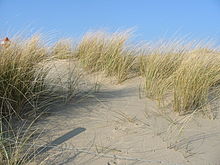Ammophila (plant)
| Ammophila | |
|---|---|
 |
|
| European marram grass Dunes near The Hague, February |
|
| Scientific classification | |
| Kingdom: | Plantae |
| (unranked): | Angiosperms |
| (unranked): | Monocots |
| (unranked): | Commelinids |
| Order: | Poales |
| Family: | Poaceae |
| Genus: |
Ammophila Host |
| Species | |
|
|
 |
|
| The range of Ammophila in North America | |
Ammophila (synonymous with Psamma P. Beauv.) is a genus of flowering plants consisting of two or three very similar species of grasses. The common names for these grasses include marram grass, bent grass, and beachgrass. These grasses are found almost exclusively on the first line of coastal sand dunes. Their extensive systems of creeping underground stems or rhizomes allow them to thrive under conditions of shifting sands and high winds, and to help stabilize and prevent coastal erosion. Ammophila species are native to the coasts of the North Atlantic Ocean where they are usually the dominant species on sand dunes. Their native range includes few inland regions, with the Great Lakes of North America being the main exception. The genus name Ammophila originates from the Greek words ἄμμος (ámmos), meaning "sand", and ϕιλος (phillia), meaning "lover".
The Ammophila grasses are widely known as examples of xerophytes, plants that can withstand dry conditions. Despite their occurrence on seacoasts, Ammophila grasses are not particularly tolerant of saline soils; they can tolerate a salinity of about 15 g/l (1.5%), which makes them "moderate halophytes".
Ammophila builds coastal sand dunes and thus stabilizes the sand. For this reason, the plants have been introduced far from their native range. Alfred Wiedemann writes that Ammophila arenaria "has been introduced into virtually every British colonial settlement within its latitudinal tolerance range, including southeast and southwest Australia, New Zealand, South Africa, the Falkland Islands, and Norfolk Island and has been reported from Argentina and Chile."Ammophila species were introduced in the late 19th century on the Pacific coast of North America as well, and massive, intentional plantings were continued at least through 1960. In essentially all of the locations where they have been introduced, Ammophila plants are now listed as invasive, and costly efforts are underway to eradicate them.
...
Wikipedia
